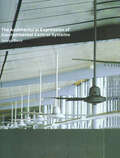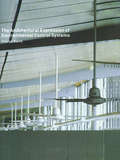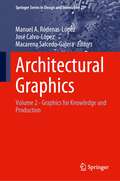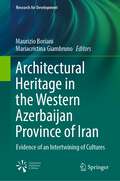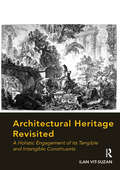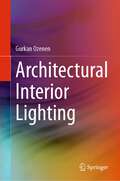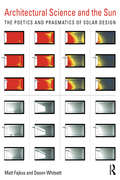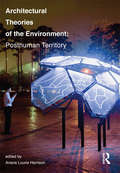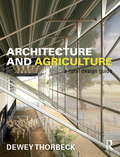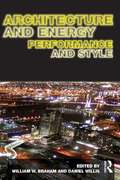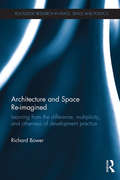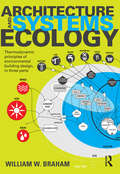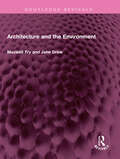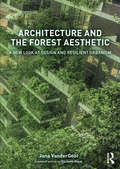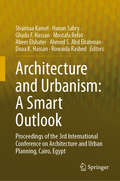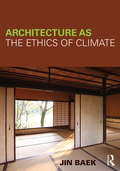- Table View
- List View
The Architectural Expression of Environmental Control Systems
by George BairdThe Architectural Expression of Environmental Control Systems examines the way project teams can approach the design and expression of both active and passive environmental control systems in a more creative way. Using seminal case studies from around the world and interviews with the architects and environmental engineers involved, the book illustrates innovative responses to client, site and user requirements, focusing upon elegant design solutions to a perennial problem. This book will inspire architects, building scientists and building services engineers to take a more creative approach to the design and expression of environmental control systems - whether active or passive, whether they influence overall building form or design detail.
The Architectural Expression of Environmental Control Systems
by George BairdThe Architectural Expression of Environmental Control Systems examines the way project teams can approach the design and expression of both active and passive environmental control systems in a more creative way. Using seminal case studies from around the world and interviews with the architects and environmental engineers involved, the book illustrates innovative responses to client, site and user requirements, focusing upon elegant design solutions to a perennial problem. This book will inspire architects, building scientists and building services engineers to take a more creative approach to the design and expression of environmental control systems - whether active or passive, whether they influence overall building form or design detail.
Architectural Graphics: Volume 2 - Graphics for Knowledge and Production (Springer Series in Design and Innovation #22)
by José Calvo-López Manuel A. Ródenas-López Macarena Salcedo-GaleraThis book reports on several advances in architectural graphics, with a special emphasis on education, training and research. It gathers a selection of contributions to the 19th International Conference on Graphic Design in Architecture, EGA 2022, held on June 2–4, 2022, in Cartagena, Spain, with the motto: "Beyond drawings. The use of architectural graphics".
Architectural Heritage in the Western Azerbaijan Province of Iran: Evidence of an Intertwining of Cultures (Research for Development)
by Maurizio Boriani Mariacristina GiambrunoThis book represents a reflection on the policies of preservation that were established and interventions for restoration that occurred in Iran before and in the years after the Khomeinist Revolution, as well as being an analysis of the impact that Italian restoration culture has had in the country. Research concerning the state of conservation and the ongoing restoration of the Armenian churches in the Khoy and Salmas areas is included, along with precise documentation of the observation of the two cities, their architecture and the context of their landscape. The problems of architectural restoration in present-day Iran and the compatible use of buildings no longer intended for worship are addressed. The book is bolstered by first-hand documentation obtained through inspections and interviews with Iranian specialists during three missions carried out between 2016 and 2018 and a large anthology of period texts that have only recently been made available for the first time for study in electronic form, including travel reports written by Westerners describing Persia between the 15th and 19th centuries.
Architectural Heritage Revisited: A Holistic Engagement of its Tangible and Intangible Constituents
by Ilan Vit-SuzanBy improving our understanding of how the tangible and intangible dimensions of heritage are correlated, we could develop a relationship with heritage that goes beyond the mere act of conservation. This book argues that we need to recognize the historic monument as a tangible aspect of a holistic expression of culture that is rooted in specific spatio-temporal conditions. However, since the latter are constantly changing, it is vital to identify an implicit contradiction with the goals of conservation. As the intangible dimensions are more dynamic, driven by the transmission, reception, and advancement of knowledge, the reliance of the prevailing treatment of heritage today, conservation, ossifies this relationship. By examining three major heritage monuments - the Pantheon, Teotihuacan's Sun Pyramid and Alhambra - the book shows how these sites are the product of multiple strategies and unforeseen agents, accumulated through history. It emphasizes how these historical trends need to be better understood in order to attain a more 'organic' relationship with heritage and offers some recommendations that should be analyzed in participative processes of deliberation: the Pantheon's continuity could be extended; the Pyramid's loss, accepted; and Alhambra's exclusion, reversed. In this way, the book invites people to engage heritage from a historical understanding that is open to critical reassessment, dialogue, and cooperation.
Architectural Heritage Revisited: A Holistic Engagement of its Tangible and Intangible Constituents
by Ilan Vit-SuzanBy improving our understanding of how the tangible and intangible dimensions of heritage are correlated, we could develop a relationship with heritage that goes beyond the mere act of conservation. This book argues that we need to recognize the historic monument as a tangible aspect of a holistic expression of culture that is rooted in specific spatio-temporal conditions. However, since the latter are constantly changing, it is vital to identify an implicit contradiction with the goals of conservation. As the intangible dimensions are more dynamic, driven by the transmission, reception, and advancement of knowledge, the reliance of the prevailing treatment of heritage today, conservation, ossifies this relationship. By examining three major heritage monuments - the Pantheon, Teotihuacan's Sun Pyramid and Alhambra - the book shows how these sites are the product of multiple strategies and unforeseen agents, accumulated through history. It emphasizes how these historical trends need to be better understood in order to attain a more 'organic' relationship with heritage and offers some recommendations that should be analyzed in participative processes of deliberation: the Pantheon's continuity could be extended; the Pyramid's loss, accepted; and Alhambra's exclusion, reversed. In this way, the book invites people to engage heritage from a historical understanding that is open to critical reassessment, dialogue, and cooperation.
Architectural Interior Lighting
by Gurkan OzenenArchitectural Interior Lighting is an essential guide to creating well-lit, visually appealing interior spaces. The book begins with an overview of light and color theory, lighting fundamentals, and design principles. It then covers artificial, natural, decorative, and professional lighting in interior design, as well as standards and regulations, controls and systems, sustainable lighting, energy efficiency, light pollution reduction, and the use of environmentally friendly materials. With a focus on practical applications and real-world examples, this book provides readers with the tools and knowledge necessary to achieve their design goals while considering the latest trends and techniques in the field. A valuable resource for professionals and students in architecture and lighting design, it will also appeal to anyone interested in creating visually stunning and functional interior spaces.
Architectural Science and the Sun: The poetics and pragmatics of solar design
by Dason Whitsett Matt FajkusArchitectural Science and the Sun synthesizes physics, climate, program, and perception to provide a foundation in the principles of architectural science related to the sun: solar geometry, solar analysis and design techniques, passive design principles, and daylighting. Part analytical handbook, part inspiration source for schematic design, the content comprises a critical component of effective sustainable design. Beyond the purely technical aspects of these topics, Architectural Science and the Sun begins with the premise that great architecture goes beyond energy performance and the visual-aesthetic to engage all of the senses. Given that the stimuli to which our senses respond are physical phenomena such as light, heat, and sound, the designer must manipulate these parameters through the craft of building form and technology to create the desired qualitative experience. This book is designed to help the reader develop that skill.
Architectural Science and the Sun: The poetics and pragmatics of solar design
by Dason Whitsett Matt FajkusArchitectural Science and the Sun synthesizes physics, climate, program, and perception to provide a foundation in the principles of architectural science related to the sun: solar geometry, solar analysis and design techniques, passive design principles, and daylighting. Part analytical handbook, part inspiration source for schematic design, the content comprises a critical component of effective sustainable design. Beyond the purely technical aspects of these topics, Architectural Science and the Sun begins with the premise that great architecture goes beyond energy performance and the visual-aesthetic to engage all of the senses. Given that the stimuli to which our senses respond are physical phenomena such as light, heat, and sound, the designer must manipulate these parameters through the craft of building form and technology to create the desired qualitative experience. This book is designed to help the reader develop that skill.
Architectural Theories of the Environment: Posthuman Territory
by Ariane Lourie HarrisonAs architects and designers, we struggle to reconcile ever increasing environmental, humanitarian, and technological demands placed on our projects. Our new geological era, the Anthropocene, marks humans as the largest environmental force on the planet and suggests that conventional anthropocentric approaches to design must accommodate a more complex understanding of the interrelationship between architecture and environment Here, for the first time, editor Ariane Lourie Harrison collects the essays of architects, theorists, and sustainable designers that together provide a framework for a posthuman understanding of the design environment. An introductory essay defines the key terms, concepts, and precedents for a posthuman approach to architecture, and nine fully illustrated case studies of buildings from around the globe demonstrate how issues raised in posthuman theory provide rich terrain for contemporary architecture, making theory concrete. By assembling a range of voices across different fields, from urban geography to critical theory to design practitioners, this anthology offers a resource for design professionals, educators, and students seeking to grapple the ecological mandate of our current period. Case studies include work by Arakawa and Gins, Arons en Gelauff, Casagrande, The Living, Minifie van Schaik, R & Sie (n), SCAPE, Studio Gang, and xDesign. Essayists include Gilles Clément, Matthew Gandy, Francesco Gonzáles de Canales, Elizabeth Grosz, Simon Guy, Seth Harrison, N. Katherine Hayles, Ursula Heise, Catherine Ingraham, Bruno Latour, William J. Mitchell, Matteo Pasquinelli, Erik Swyngedouw, Sarah Whatmore, Jennifer Wolch, Cary Wolfe, and Albena Yaneva
Architectural Theories of the Environment: Posthuman Territory
by Ariane Lourie HarrisonAs architects and designers, we struggle to reconcile ever increasing environmental, humanitarian, and technological demands placed on our projects. Our new geological era, the Anthropocene, marks humans as the largest environmental force on the planet and suggests that conventional anthropocentric approaches to design must accommodate a more complex understanding of the interrelationship between architecture and environment Here, for the first time, editor Ariane Lourie Harrison collects the essays of architects, theorists, and sustainable designers that together provide a framework for a posthuman understanding of the design environment. An introductory essay defines the key terms, concepts, and precedents for a posthuman approach to architecture, and nine fully illustrated case studies of buildings from around the globe demonstrate how issues raised in posthuman theory provide rich terrain for contemporary architecture, making theory concrete. By assembling a range of voices across different fields, from urban geography to critical theory to design practitioners, this anthology offers a resource for design professionals, educators, and students seeking to grapple the ecological mandate of our current period. Case studies include work by Arakawa and Gins, Arons en Gelauff, Casagrande, The Living, Minifie van Schaik, R & Sie (n), SCAPE, Studio Gang, and xDesign. Essayists include Gilles Clément, Matthew Gandy, Francesco Gonzáles de Canales, Elizabeth Grosz, Simon Guy, Seth Harrison, N. Katherine Hayles, Ursula Heise, Catherine Ingraham, Bruno Latour, William J. Mitchell, Matteo Pasquinelli, Erik Swyngedouw, Sarah Whatmore, Jennifer Wolch, Cary Wolfe, and Albena Yaneva
Architecture and Agriculture: A Rural Design Guide
by Dewey ThorbeckArchitecture and Agriculture: A Rural Design Guide presents architectural guidelines for buildings designed and constructed in rural landscapes by emphasizing their connections with function, culture, climate, and place. Following on from the author’s first book Rural Design, the book discusses in detail the buildings that humans construct in support of agriculture. By examining case studies from around the world including Australia, China, Japan, Norway, Poland, Japan, Portugal, North America, Africa and the Southeast Asia it informs readers about the potentials, opportunities, and values of rural architecture, and how they have been developed to create sustainable landscapes and sustainable buildings for rapidly changing rural futures.
Architecture and Agriculture: A Rural Design Guide
by Dewey ThorbeckArchitecture and Agriculture: A Rural Design Guide presents architectural guidelines for buildings designed and constructed in rural landscapes by emphasizing their connections with function, culture, climate, and place. Following on from the author’s first book Rural Design, the book discusses in detail the buildings that humans construct in support of agriculture. By examining case studies from around the world including Australia, China, Japan, Norway, Poland, Japan, Portugal, North America, Africa and the Southeast Asia it informs readers about the potentials, opportunities, and values of rural architecture, and how they have been developed to create sustainable landscapes and sustainable buildings for rapidly changing rural futures.
Architecture and Energy: Performance and Style
by William W. Braham Daniel WillisDoes energy consumption influence architectural style? Should more energy-efficient buildings look different? Can that "look" be used to explain or enhance their performance? Architecture and Energy provides architects and architectural theorists with more durable arguments for environmental design decisions, arguments addressing three different scales or aspects of contemporary construction. By drawing together essays from the leading experts in the field, this book engages with crucial issues in sustainable design, such as: The larger role of energy in forming the cultural and economic systems in which architecture is conceived, constructed, and evaluated The different measures and meanings of energy "performance" and how those measures are realized in buildings The specific ways in which energy use translates into the visible aspects of architectural style. Drawing on research from the UK, US, Europe, and Asia the book outlines the problems surrounding energy and architecture and provides the reader with a considered overview of this important topic.
Architecture and Energy: Performance and Style
by William W. Braham Daniel WillisDoes energy consumption influence architectural style? Should more energy-efficient buildings look different? Can that "look" be used to explain or enhance their performance? Architecture and Energy provides architects and architectural theorists with more durable arguments for environmental design decisions, arguments addressing three different scales or aspects of contemporary construction. By drawing together essays from the leading experts in the field, this book engages with crucial issues in sustainable design, such as: The larger role of energy in forming the cultural and economic systems in which architecture is conceived, constructed, and evaluated The different measures and meanings of energy "performance" and how those measures are realized in buildings The specific ways in which energy use translates into the visible aspects of architectural style. Drawing on research from the UK, US, Europe, and Asia the book outlines the problems surrounding energy and architecture and provides the reader with a considered overview of this important topic.
Architecture and Space Re-imagined: Learning from the difference, multiplicity, and otherness of development practice (Routledge Research in Place, Space and Politics)
by Richard BowerAs with so many facets of contemporary western life, architecture and space are often experienced and understood as a commodity or product. The premise of this book is to offer alternatives to the practices and values of such westernised space and Architecture (with a capital A), by exploring the participatory and grass-roots practices used in alternative development models in the Global South. This process re-contextualises the spaces, values, and relationships produced by such alternative methods of development and social agency. It asks whether such spatial practices provide concrete realisations of some key concepts of Western spatial theory, questioning whether we might challenge the space and architectures of capitalist development by learning from the places and practices of others. Exploring these themes offers a critical examination of alternative development practices methods in the Global South, re-contextualising them as architectural engagements with socio-political space. The comparison of such interdisciplinary contexts and discourses reveals the political, social, and economic resonances inherent between these previously unconnected spatial protagonists. The interdependence of spatial issues of choice, value, and identity are revealed through a comparative study of the discourses of Henri Lefebvre, John Turner, Doreen Massey, and Nabeel Hamdi. These key protagonists offer a critical framework of discourses from which further connections to socio-spatial discourses and concepts are made, including post-marxist theory, orientalism, post-structural pluralism, development anthropology, post-colonial theory, hybridity, difference and subalterneity. By looking to the spaces and practices of alternative development in the Global South this book offers a critical reflection upon the working practices of Westernised architecture and other spatial and political practices. In exploring the methodologies, implications and values of such participatory development practices this book ultimately seeks to articulate the positive potential and political of learning from the difference, multiplicity, and otherness of development practice in order to re-imagine architecture and space. .
Architecture and Space Re-imagined: Learning from the difference, multiplicity, and otherness of development practice (Routledge Research in Place, Space and Politics)
by Richard BowerAs with so many facets of contemporary western life, architecture and space are often experienced and understood as a commodity or product. The premise of this book is to offer alternatives to the practices and values of such westernised space and Architecture (with a capital A), by exploring the participatory and grass-roots practices used in alternative development models in the Global South. This process re-contextualises the spaces, values, and relationships produced by such alternative methods of development and social agency. It asks whether such spatial practices provide concrete realisations of some key concepts of Western spatial theory, questioning whether we might challenge the space and architectures of capitalist development by learning from the places and practices of others. Exploring these themes offers a critical examination of alternative development practices methods in the Global South, re-contextualising them as architectural engagements with socio-political space. The comparison of such interdisciplinary contexts and discourses reveals the political, social, and economic resonances inherent between these previously unconnected spatial protagonists. The interdependence of spatial issues of choice, value, and identity are revealed through a comparative study of the discourses of Henri Lefebvre, John Turner, Doreen Massey, and Nabeel Hamdi. These key protagonists offer a critical framework of discourses from which further connections to socio-spatial discourses and concepts are made, including post-marxist theory, orientalism, post-structural pluralism, development anthropology, post-colonial theory, hybridity, difference and subalterneity. By looking to the spaces and practices of alternative development in the Global South this book offers a critical reflection upon the working practices of Westernised architecture and other spatial and political practices. In exploring the methodologies, implications and values of such participatory development practices this book ultimately seeks to articulate the positive potential and political of learning from the difference, multiplicity, and otherness of development practice in order to re-imagine architecture and space. .
Architecture and Systems Ecology: Thermodynamic Principles of Environmental Building Design, in three parts
by William W. BrahamModern buildings are both wasteful machines that can be made more efficient and instruments of the massive, metropolitan system engendered by the power of high-quality fuels. A comprehensive method of environmental design must reconcile the techniques of efficient building design with the radical urban and economic reorganization that we face. Over the coming century, we will be challenged to return to the renewable resource base of the eighteenth-century city with the knowledge, technologies, and expectations of the twenty-first-century metropolis. This book explores the architectural implications of systems ecology, which extends the principles of thermodynamics from the nineteenth-century focus on more efficient machinery to the contemporary concern with the resilient self-organization of ecosystems. Written with enough technical material to explain the methods, it does not include in-text equations or calculations, relying instead on the energy system diagrams to convey the argument. Architecture and Systems Ecology has minimal technical jargon and an emphasis on intelligible design conclusions, making it suitable for architecture students and professionals who are engaged with the fundamental issues faced by sustainable design. The energy systems language provides a holistic context for the many kinds of performance already evaluated in architecture—from energy use to material selection and even the choice of building style. It establishes the foundation for environmental principles of design that embrace the full complexity of our current situation. Architecture succeeds best when it helps shape, accommodate, and represent new ways of living together.
Architecture and Systems Ecology: Thermodynamic Principles of Environmental Building Design, in three parts
by William W. BrahamModern buildings are both wasteful machines that can be made more efficient and instruments of the massive, metropolitan system engendered by the power of high-quality fuels. A comprehensive method of environmental design must reconcile the techniques of efficient building design with the radical urban and economic reorganization that we face. Over the coming century, we will be challenged to return to the renewable resource base of the eighteenth-century city with the knowledge, technologies, and expectations of the twenty-first-century metropolis. This book explores the architectural implications of systems ecology, which extends the principles of thermodynamics from the nineteenth-century focus on more efficient machinery to the contemporary concern with the resilient self-organization of ecosystems. Written with enough technical material to explain the methods, it does not include in-text equations or calculations, relying instead on the energy system diagrams to convey the argument. Architecture and Systems Ecology has minimal technical jargon and an emphasis on intelligible design conclusions, making it suitable for architecture students and professionals who are engaged with the fundamental issues faced by sustainable design. The energy systems language provides a holistic context for the many kinds of performance already evaluated in architecture—from energy use to material selection and even the choice of building style. It establishes the foundation for environmental principles of design that embrace the full complexity of our current situation. Architecture succeeds best when it helps shape, accommodate, and represent new ways of living together.
Architecture and the Environment (Routledge Revivals)
by Maxwell Fry Jane DrewFirst published in 1976 Architecture and the Environment is based on the authors very successful Architecture of Children. The original book has been completely revised and new illustrations have been specially drawn. This book gives a comprehensive account of the role of architecture in the environment of a constantly developing world. It traces the history of building from its most primitive origins to the complex architecture of the current times. The book takes as a starting- point ideas that will be familiar to all its readers, then leads them on to an examination of the attitudes and approaches of architects and planners, so that they can follow the creative process step by step. The style of the book is direct and very readable, with a minimum of technological language and will be useful for general readers interested in architecture.
Architecture and the Environment (Routledge Revivals)
by Maxwell Fry Jane DrewFirst published in 1976 Architecture and the Environment is based on the authors very successful Architecture of Children. The original book has been completely revised and new illustrations have been specially drawn. This book gives a comprehensive account of the role of architecture in the environment of a constantly developing world. It traces the history of building from its most primitive origins to the complex architecture of the current times. The book takes as a starting- point ideas that will be familiar to all its readers, then leads them on to an examination of the attitudes and approaches of architects and planners, so that they can follow the creative process step by step. The style of the book is direct and very readable, with a minimum of technological language and will be useful for general readers interested in architecture.
Architecture and the Forest Aesthetic: A New Look at Design and Resilient Urbanism
by Jana VanderGootDespite population trends toward urbanization, the forest continues to have a strong appeal to the human imagination, and the human preference for forest over many other types of terrain is well documented. This book re-imagines architecture and urbanism by allowing the forest to be a prominent consideration in the language of design, thus recognizing the forest as essential rather than just incidental to human well-being. In Architecture and the Forest Aesthetic, forest is a large-scale urban construct that is far more extensive and nuanced than trees and shrubbery. The forest aesthetic opens designers to the forest as a model for an urban architecture of permeable floors, protective canopies, connected food chains, beneficial decomposition, and resilient ecologies. Much can be learned about these features of the forest from the natural sciences; however, when they are given due consideration technically and metaphorically in the design of urban habitat, the places in which humans live become living forests. What is present here in Architecture and the Forest Aesthetic is both a review of many ingenious ways in which the forest aesthetic has already been expressed in design and urbanism, and an encouragement to further use the forest aesthetic in design language and design outcomes. Case study projects featured include the Chilotan building craft of Southern Chile, the yaki sugi of Japan, the Biltmore Forest in the Southeastern United States, the Australian capital city Canberra, Bosco Verticale in Milan, Italy, the Beijing Olympic Forest Park in China, and more.
Architecture and the Forest Aesthetic: A New Look at Design and Resilient Urbanism
by Jana VanderGootDespite population trends toward urbanization, the forest continues to have a strong appeal to the human imagination, and the human preference for forest over many other types of terrain is well documented. This book re-imagines architecture and urbanism by allowing the forest to be a prominent consideration in the language of design, thus recognizing the forest as essential rather than just incidental to human well-being. In Architecture and the Forest Aesthetic, forest is a large-scale urban construct that is far more extensive and nuanced than trees and shrubbery. The forest aesthetic opens designers to the forest as a model for an urban architecture of permeable floors, protective canopies, connected food chains, beneficial decomposition, and resilient ecologies. Much can be learned about these features of the forest from the natural sciences; however, when they are given due consideration technically and metaphorically in the design of urban habitat, the places in which humans live become living forests. What is present here in Architecture and the Forest Aesthetic is both a review of many ingenious ways in which the forest aesthetic has already been expressed in design and urbanism, and an encouragement to further use the forest aesthetic in design language and design outcomes. Case study projects featured include the Chilotan building craft of Southern Chile, the yaki sugi of Japan, the Biltmore Forest in the Southeastern United States, the Australian capital city Canberra, Bosco Verticale in Milan, Italy, the Beijing Olympic Forest Park in China, and more.
Architecture and Urbanism: Proceedings of the 3rd International Conference on Architecture and Urban Planning, Cairo, Egypt
by Shaimaa Kamel Hanan Sabry Ghada F. Hassan Mostafa Refat Abeer Elshater Ahmed S. Abd Elrahman Doaa K. Hassan Rowaida RashedThis proceedings addresses the challenges of urbanization that gravely affect the world’s ecosystems. To become efficiently sustainable and regenerative, buildings and cities need to adopt smart solutions. This book discusses innovations of the built environment while depicting how such practices can transform future buildings and urban areas into places of higher value and quality. The book aims to examine the interrelationship between people, nature and technology, which is essential in pursuing smart environments that optimize human wellbeing, motivation and vitality, as well as promoting cohesive and inclusive societies: Urban Sociology - Community Involvement - Place-making and Cultural Continuity – Environmental Psychology - Smart living - Just City. The book presents exemplary practical experiences that reflect smart strategies, technologies and innovations, by established and emerging professionals, provides a forum of real-life discourse. The primary audience for the work will be from the fields of architecture, urban planning and built-environment systems, including multi-disciplinary academics as well as professionals.
Architecture as the Ethics of Climate
by Jin BaekAt a time when climate and ethics have become so important to architectural debate, this book proposes an entirely new way for architects to engage with these core issues. Drawing on Tetsuro Watsuji‘s (1889-1960) philosophy, the book illuminates climate not as a collection of objective natural phenomena, but as a concrete form of bond in which "who we are"—the subjective human experience—is indivisibly intertwined with the natural phenomena. The book further elucidates the inter-personal nature of climatic experiences, criticizing a view that sees atmospheric effects of climate under the guise of personal experientialism and reinforcing the linkage between climate and ethos as the appropriateness of a setting for human affairs. This ethical premise of climate stretches the horizon of sustainability as pertaining not only to man’s solitary relationship with natural phenomena—a predominant trend in contemporary discourse of sustainability—but also to man’s relationship with man. Overcoming climatic determinism—regional determinism, too—and expanding the ethics of the inter-personal to the level where the whole and particulars are joined through the dialectics of the mutually-negating opposites, Jin Baek develops a new thesis engaging with the very urgent issues inherent in sustainable architecture. Crucially, the book explores examples that join climate and the dynamics of the inter-personal, including: Japanese vernacular residential architecture the white residential architecture of Richard Neutra contemporary architectural works and urban artifacts by Tadao Ando and Aldo Rossi Beautifully illustrated, this book is an important contribution to the discourse which surrounds architecture, climate and ethics and encourages the reader to think more broadly about how to respond to the current challenges facing the profession.
